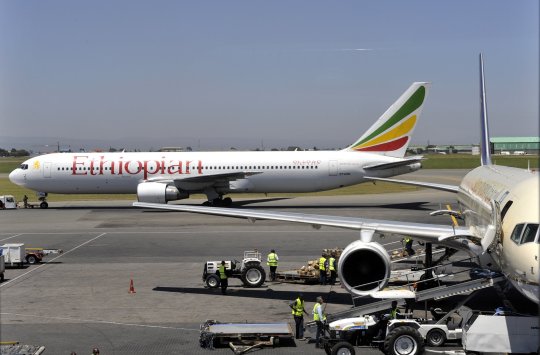
The pilot of the Ethiopian Airlines plane requested permission ‘in a panicky voice’ to return to the airport just moments before it crashed and killed 157 people, including nine Britons, it has been revealed.
He told controllers he was having problems keeping the aircraft steady shortly after take-off, according to an account of cockpit voice recordings from the airline’s chief executive.
The pilot ‘reported back to air traffic controllers that he was having flight control problems’, but cited no other issues, Tewolde GebreMariam told the Wall Street Journal.
A worker who reviewed air traffic communications from Sunday’s 302 flight said airport controllers noticed the plane was moving up and down by hundreds of feet at an unusually fast speed, reported the New York Times.
An Airline spokesperson has confirmed that the pilot was given permission to turn back to Bole airport, shortly after take-off, but the plane crashed just minutes later outside the capital, Addis Ababa, killing all passengers on board. French authorities are now analysing the plane’s flight data and voice recorders, while in Ethiopia officials are taking DNA samples from victims’ relatives to identify the remains.
There were no survivors among the 148 passengers and nine crew members – from at least 35 nationalities – on board. So far, seven out of the nine Britons who died have been named. Sam Pegram, 25, Joanna Toole, 36, Josepth Waithaka, 55, Sarah Auffret, 30, Oliver Vick, 45, and mother and son Sahra Hassan Said and Nasrudin Abdulkadir, were among those who tragically lost their lives in the accident.
At the crash scene in Hejere, around 31 miles from Addis Ababa, searchers continued to pick through the debris. Blue plastic sheeting covered the wreckage of the plane, which had been en-route to the Kenyan capital Nairobi.
Anxious family members who had begun giving DNA samples waited for news on when identifications of remains would begin, and whether they would have anything to bury.
Faysal Hussein, whose cousin was killed in the crash, said that they have ‘not been told what they have found so far’.
He said: ‘We are sitting here like forever. We were taken to the crash site on Wednesday but not allowed to get a closer look.
‘And then yesterday Ethiopian Airlines officials called us to a meeting but they don’t have anything to say. ‘This is frustrating.’
Following the horrific accident, numerous countries and airlines across the world have decided to halt the use of their Boeing 737 Max 8 planes – the same aircraft model involved in the crash.
Now the US-based aircraft manufacturer faces the challenge of proving the jets are safe to fly, amid suspicions that faulty software might have contributed to two crashes that killed 346 people in less than six months.
The decision to send the flight recorders to France was seen as a way of scolding the US, which waited until Wednesday to ground the Boeing 737 Max 8 jets – longer than most other countries. However, the US National Transportation Safety Board sent three investigators to help French authorities in their analysis.
Boeing executives also announced that they had paused delivery of the Max, although the company planned to continue building the planes while it weighs up the effect of the grounding on production.
The US Federal Aviation Administration said regulators had new satellite evidence which showed the movements of the Ethiopian Airlines Flight 302 were similar to those of Lion Air Flight 610. That flight crashed into the Java Sea off Indonesia in October, killing 189 people. The crew on the Lion Air Flight also tried to turn back to the airport.
At the very least, the plane-maker will need to finish updating software that might have played a role in the Lion Air crash, say aviation experts, while engineers are currently making changes to the system. Boeing said it supports the grounding of its planes as a precautionary step but reiterated that it has ‘full confidence’ in the safety of the 737 Max.
But satellite-based data showed that both the Ethiopian Airlines and Lion Air planes flew with erratic altitude changes that could indicate that the pilots were struggling to control the aircraft. The Max is the latest upgrade and because its engines were larger and heavier, they were placed higher and further forward on the wings.
That characteristic raised concerns that the plane might be slightly more prone to an aerodynamic stall if not flown properly, so Boeing developed software to prevent that.
Investigators looking into the Indonesian crash are examining whether the software automatically pushed the plane’s nose down repeatedly, and whether the Lion Air pilots knew how to solve that problem by throwing toggle switches and cancelling the automated nose-down commands. Ethiopian Airlines said its pilots received special training on how to deal with the Max’s anti-stall software.
***
Source:
Metro UK





